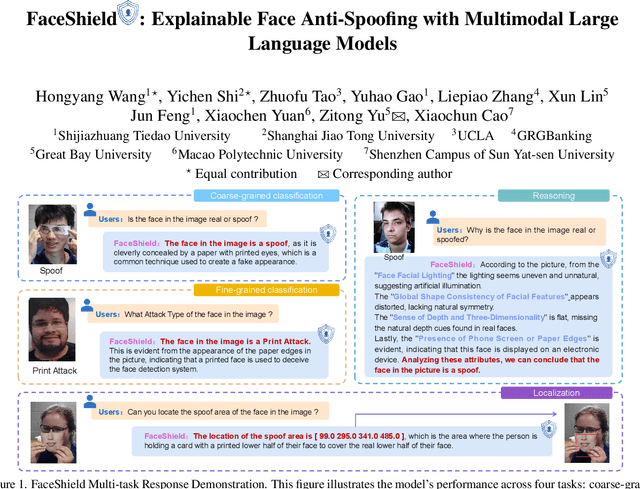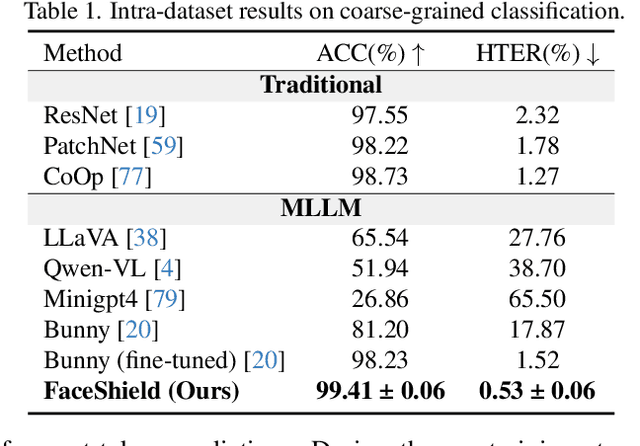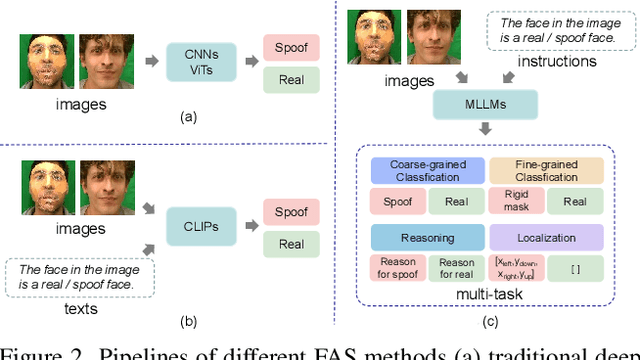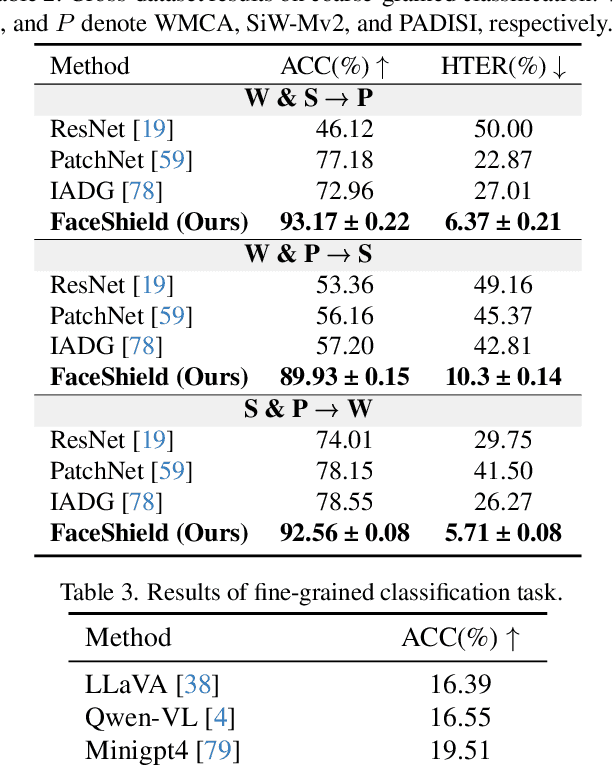Zitong Yu
Agent4FaceForgery: Multi-Agent LLM Framework for Realistic Face Forgery Detection
Sep 16, 2025Abstract:Face forgery detection faces a critical challenge: a persistent gap between offline benchmarks and real-world efficacy,which we attribute to the ecological invalidity of training data.This work introduces Agent4FaceForgery to address two fundamental problems: (1) how to capture the diverse intents and iterative processes of human forgery creation, and (2) how to model the complex, often adversarial, text-image interactions that accompany forgeries in social media. To solve this,we propose a multi-agent framework where LLM-poweredagents, equipped with profile and memory modules, simulate the forgery creation process. Crucially, these agents interact in a simulated social environment to generate samples labeled for nuanced text-image consistency, moving beyond simple binary classification. An Adaptive Rejection Sampling (ARS) mechanism ensures data quality and diversity. Extensive experiments validate that the data generated by our simulationdriven approach brings significant performance gains to detectors of multiple architectures, fully demonstrating the effectiveness and value of our framework.
LLM Enabled Multi-Agent System for 6G Networks: Framework and Method of Dual-Loop Edge-Terminal Collaboration
Sep 05, 2025Abstract:The ubiquitous computing resources in 6G networks provide ideal environments for the fusion of large language models (LLMs) and intelligent services through the agent framework. With auxiliary modules and planning cores, LLM-enabled agents can autonomously plan and take actions to deal with diverse environment semantics and user intentions. However, the limited resources of individual network devices significantly hinder the efficient operation of LLM-enabled agents with complex tool calls, highlighting the urgent need for efficient multi-level device collaborations. To this end, the framework and method of the LLM-enabled multi-agent system with dual-loop terminal-edge collaborations are proposed in 6G networks. Firstly, the outer loop consists of the iterative collaborations between the global agent and multiple sub-agents deployed on edge servers and terminals, where the planning capability is enhanced through task decomposition and parallel sub-task distribution. Secondly, the inner loop utilizes sub-agents with dedicated roles to circularly reason, execute, and replan the sub-task, and the parallel tool calling generation with offloading strategies is incorporated to improve efficiency. The improved task planning capability and task execution efficiency are validated through the conducted case study in 6G-supported urban safety governance. Finally, the open challenges and future directions are thoroughly analyzed in 6G networks, accelerating the advent of the 6G era.
SAC-MIL: Spatial-Aware Correlated Multiple Instance Learning for Histopathology Whole Slide Image Classification
Sep 04, 2025Abstract:We propose Spatial-Aware Correlated Multiple Instance Learning (SAC-MIL) for performing WSI classification. SAC-MIL consists of a positional encoding module to encode position information and a SAC block to perform full instance correlations. The positional encoding module utilizes the instance coordinates within the slide to encode the spatial relationships instead of the instance index in the input WSI sequence. The positional encoding module can also handle the length extrapolation issue where the training and testing sequences have different lengths. The SAC block is an MLP-based method that performs full instance correlation in linear time complexity with respect to the sequence length. Due to the simple structure of MLP, it is easy to deploy since it does not require custom CUDA kernels, compared to Transformer-based methods for WSI classification. SAC-MIL has achieved state-of-the-art performance on the CAMELYON-16, TCGA-LUNG, and TCGA-BRAC datasets. The code will be released upon acceptance.
Dynamic Collaboration of Multi-Language Models based on Minimal Complete Semantic Units
Aug 26, 2025Abstract:This paper investigates the enhancement of reasoning capabilities in language models through token-level multi-model collaboration. Our approach selects the optimal tokens from the next token distributions provided by multiple models to perform autoregressive reasoning. Contrary to the assumption that more models yield better results, we introduce a distribution distance-based dynamic selection strategy (DDS) to optimize the multi-model collaboration process. To address the critical challenge of vocabulary misalignment in multi-model collaboration, we propose the concept of minimal complete semantic units (MCSU), which is simple yet enables multiple language models to achieve natural alignment within the linguistic space. Experimental results across various benchmarks demonstrate the superiority of our method. The code will be available at https://github.com/Fanye12/DDS.
Distribution-Specific Learning for Joint Salient and Camouflaged Object Detection
Aug 08, 2025Abstract:Salient object detection (SOD) and camouflaged object detection (COD) are two closely related but distinct computer vision tasks. Although both are class-agnostic segmentation tasks that map from RGB space to binary space, the former aims to identify the most salient objects in the image, while the latter focuses on detecting perfectly camouflaged objects that blend into the background in the image. These two tasks exhibit strong contradictory attributes. Previous works have mostly believed that joint learning of these two tasks would confuse the network, reducing its performance on both tasks. However, here we present an opposite perspective: with the correct approach to learning, the network can simultaneously possess the capability to find both salient and camouflaged objects, allowing both tasks to benefit from joint learning. We propose SCJoint, a joint learning scheme for SOD and COD tasks, assuming that the decoding processes of SOD and COD have different distribution characteristics. The key to our method is to learn the respective means and variances of the decoding processes for both tasks by inserting a minimal amount of task-specific learnable parameters within a fully shared network structure, thereby decoupling the contradictory attributes of the two tasks at a minimal cost. Furthermore, we propose a saliency-based sampling strategy (SBSS) to sample the training set of the SOD task to balance the training set sizes of the two tasks. In addition, SBSS improves the training set quality and shortens the training time. Based on the proposed SCJoint and SBSS, we train a powerful generalist network, named JoNet, which has the ability to simultaneously capture both ``salient" and ``camouflaged". Extensive experiments demonstrate the competitive performance and effectiveness of our proposed method. The code is available at https://github.com/linuxsino/JoNet.
SVC 2025: the First Multimodal Deception Detection Challenge
Aug 06, 2025Abstract:Deception detection is a critical task in real-world applications such as security screening, fraud prevention, and credibility assessment. While deep learning methods have shown promise in surpassing human-level performance, their effectiveness often depends on the availability of high-quality and diverse deception samples. Existing research predominantly focuses on single-domain scenarios, overlooking the significant performance degradation caused by domain shifts. To address this gap, we present the SVC 2025 Multimodal Deception Detection Challenge, a new benchmark designed to evaluate cross-domain generalization in audio-visual deception detection. Participants are required to develop models that not only perform well within individual domains but also generalize across multiple heterogeneous datasets. By leveraging multimodal data, including audio, video, and text, this challenge encourages the design of models capable of capturing subtle and implicit deceptive cues. Through this benchmark, we aim to foster the development of more adaptable, explainable, and practically deployable deception detection systems, advancing the broader field of multimodal learning. By the conclusion of the workshop competition, a total of 21 teams had submitted their final results. https://sites.google.com/view/svc-mm25 for more information.
AU-LLM: Micro-Expression Action Unit Detection via Enhanced LLM-Based Feature Fusion
Jul 29, 2025Abstract:The detection of micro-expression Action Units (AUs) is a formidable challenge in affective computing, pivotal for decoding subtle, involuntary human emotions. While Large Language Models (LLMs) demonstrate profound reasoning abilities, their application to the fine-grained, low-intensity domain of micro-expression AU detection remains unexplored. This paper pioneers this direction by introducing \textbf{AU-LLM}, a novel framework that for the first time uses LLM to detect AUs in micro-expression datasets with subtle intensities and the scarcity of data. We specifically address the critical vision-language semantic gap, the \textbf{Enhanced Fusion Projector (EFP)}. The EFP employs a Multi-Layer Perceptron (MLP) to intelligently fuse mid-level (local texture) and high-level (global semantics) visual features from a specialized 3D-CNN backbone into a single, information-dense token. This compact representation effectively empowers the LLM to perform nuanced reasoning over subtle facial muscle movements.Through extensive evaluations on the benchmark CASME II and SAMM datasets, including stringent Leave-One-Subject-Out (LOSO) and cross-domain protocols, AU-LLM establishes a new state-of-the-art, validating the significant potential and robustness of LLM-based reasoning for micro-expression analysis. The codes are available at https://github.com/ZS-liu-JLU/AU-LLMs.
M2BeamLLM: Multimodal Sensing-empowered mmWave Beam Prediction with Large Language Models
Jun 17, 2025Abstract:This paper introduces a novel neural network framework called M2BeamLLM for beam prediction in millimeter-wave (mmWave) massive multi-input multi-output (mMIMO) communication systems. M2BeamLLM integrates multi-modal sensor data, including images, radar, LiDAR, and GPS, leveraging the powerful reasoning capabilities of large language models (LLMs) such as GPT-2 for beam prediction. By combining sensing data encoding, multimodal alignment and fusion, and supervised fine-tuning (SFT), M2BeamLLM achieves significantly higher beam prediction accuracy and robustness, demonstrably outperforming traditional deep learning (DL) models in both standard and few-shot scenarios. Furthermore, its prediction performance consistently improves with increased diversity in sensing modalities. Our study provides an efficient and intelligent beam prediction solution for vehicle-to-infrastructure (V2I) mmWave communication systems.
FEALLM: Advancing Facial Emotion Analysis in Multimodal Large Language Models with Emotional Synergy and Reasoning
May 19, 2025Abstract:Facial Emotion Analysis (FEA) plays a crucial role in visual affective computing, aiming to infer a person's emotional state based on facial data. Scientifically, facial expressions (FEs) result from the coordinated movement of facial muscles, which can be decomposed into specific action units (AUs) that provide detailed emotional insights. However, traditional methods often struggle with limited interpretability, constrained generalization and reasoning abilities. Recently, Multimodal Large Language Models (MLLMs) have shown exceptional performance in various visual tasks, while they still face significant challenges in FEA due to the lack of specialized datasets and their inability to capture the intricate relationships between FEs and AUs. To address these issues, we introduce a novel FEA Instruction Dataset that provides accurate and aligned FE and AU descriptions and establishes causal reasoning relationships between them, followed by constructing a new benchmark, FEABench. Moreover, we propose FEALLM, a novel MLLM architecture designed to capture more detailed facial information, enhancing its capability in FEA tasks. Our model demonstrates strong performance on FEABench and impressive generalization capability through zero-shot evaluation on various datasets, including RAF-DB, AffectNet, BP4D, and DISFA, showcasing its robustness and effectiveness in FEA tasks. The dataset and code will be available at https://github.com/953206211/FEALLM.
FaceShield: Explainable Face Anti-Spoofing with Multimodal Large Language Models
May 14, 2025



Abstract:Face anti-spoofing (FAS) is crucial for protecting facial recognition systems from presentation attacks. Previous methods approached this task as a classification problem, lacking interpretability and reasoning behind the predicted results. Recently, multimodal large language models (MLLMs) have shown strong capabilities in perception, reasoning, and decision-making in visual tasks. However, there is currently no universal and comprehensive MLLM and dataset specifically designed for FAS task. To address this gap, we propose FaceShield, a MLLM for FAS, along with the corresponding pre-training and supervised fine-tuning (SFT) datasets, FaceShield-pre10K and FaceShield-sft45K. FaceShield is capable of determining the authenticity of faces, identifying types of spoofing attacks, providing reasoning for its judgments, and detecting attack areas. Specifically, we employ spoof-aware vision perception (SAVP) that incorporates both the original image and auxiliary information based on prior knowledge. We then use an prompt-guided vision token masking (PVTM) strategy to random mask vision tokens, thereby improving the model's generalization ability. We conducted extensive experiments on three benchmark datasets, demonstrating that FaceShield significantly outperforms previous deep learning models and general MLLMs on four FAS tasks, i.e., coarse-grained classification, fine-grained classification, reasoning, and attack localization. Our instruction datasets, protocols, and codes will be released soon.
 Add to Chrome
Add to Chrome Add to Firefox
Add to Firefox Add to Edge
Add to Edge